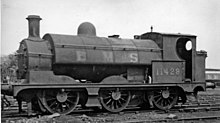The London, Midland and Scottish Railway had the largest stock of steam locomotives of any of the 'Big Four' Grouping, i.e. pre-Nationalisation railway companies in the UK. Despite early troubles arising from factions within the new company, the LMS went on to build some very successful designs; many lasted until the end of steam traction on British Railways in 1968. For an explanation of numbering and classification, see British Rail locomotive and multiple unit numbering and classification.
George Hughes was an English locomotive engineer, and chief mechanical engineer (CME) of the Lancashire and Yorkshire Railway (L&YR) and the London, Midland and Scottish Railway (LMS).

The BR Standard Class 2 2-6-0 is a class of steam locomotive, one of the British Railways Standard classes of the 1950s. They were physically the smallest of the Standard classes; 65 were built.

The London, Midland and Scottish Railway (LMS) Hughes Crab or Horwich Mogul is a class of mixed-traffic 2-6-0 steam locomotive built between 1926 and 1932. They are noted for their appearance with large steeply-angled cylinders to accommodate a restricted loading gauge.

Horwich Works was a railway works built in 1886 by the Lancashire and Yorkshire Railway (LYR) in Horwich, near Bolton, in North West England when the company moved from its original works at Miles Platting, Manchester.

The London, Midland and Scottish Railway (LMS) Fowler 3F0-6-0T is a class of steam locomotives, often known as Jinty. They represent the ultimate development of the Midland Railway's six-coupled tank engines. They could reach speeds of up to 60 mph (97 km/h).
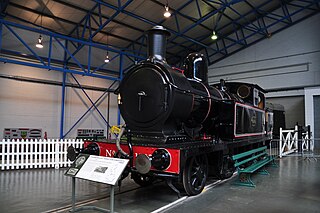
The Lancashire and Yorkshire Railway Class 5 were 2-4-2T steam locomotives designed by Chief Mechanical Engineer (CME) John Aspinall and introduced from 1889 for local passenger work. Later batches included progressive modifications such as extended coal bunkers and Belpaire fireboxes. The final batch built from 1911 to 1914 under George Hughes incorporating superheated boilers gave increased tractive effort, others were also rebuilt to this standard. When Hughes introduced his classification system in 1919, the more powerful superheated locomotives were designated Class 6. The final examples were withdrawn in 1961.

The Lancashire and Yorkshire Railway Class 25 is a class of 0-6-0 steam locomotive. They were introduced to the Lancashire and Yorkshire Railway in 1876 by new locomotive superintendent William Barton Wright and 280 were built in total. Of these, 230 were later converted to saddle tanks by John Aspinall, to become L&YR Class 23. They were nicknamed "Ironclads" after the ships of the same name being developed at the time.
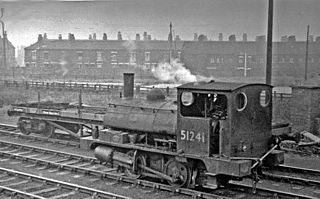
The L&YR Class 21 is a class of small 0-4-0ST steam locomotive built by the Lancashire and Yorkshire Railway for shunting duties. They were nicknamed Pugs.

The Lancashire and Yorkshire Railway Class 27 is a class of 0-6-0 steam locomotive designed for freight work on the Lancashire and Yorkshire Railway (L&YR).

The Lancashire and Yorkshire Railway Class 28 was a class of 0-6-0 steam locomotive, designed by George Hughes for the Lancashire and Yorkshire Railway (L&YR). It was a rebuild of Aspinall's Class 27, with the addition of a Belpaire firebox and the extension of the footplate and front sandboxes. It was similar, but had larger cylinders and a superheater. It had 5-foot-1-inch (1.549 m) wheels.
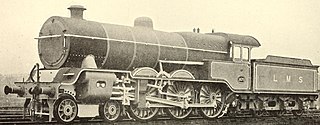
The Lancashire and Yorkshire Railway (L&YR) Class 8 was a four-cylinder 4-6-0 express passenger locomotive designed by George Hughes introduced in 1908.
The Lancashire and Yorkshire Railway (L&YR) Class 7 was a class of Atlantic passenger steam locomotives to the design of John Aspinall. Forty were built between 1899 and 1902. They were known as "High-Flyers" as a result of having a high-pitched boiler that was supposed to increase stability at speed. All passed into London, Midland and Scottish Railway (LMS) ownership on the grouping of 1923, becoming the LMS's only Atlantic tender engine class. The LMS gave them the power classification 2P. Withdrawals started in 1926, and the last was withdrawn in 1934. None were preserved.
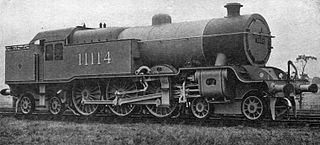
The Lancashire and Yorkshire RailwayHughes 4-6-4T was a class of steam locomotives. They were a 4-6-4T tank engine version of the L&YR Class 8, hence they were known as "Dreadnought tanks".
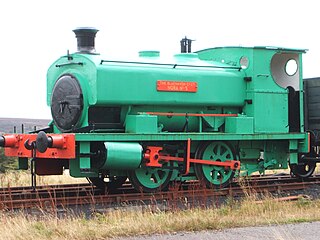
'Pug' locomotives are small steam locomotives which were produced for light shunting work, usually at dockyards, factory sites, steelworks, collieries, and other similar locations. The name is derived from a common term in Scotland for a small industrial shunting engine, typically an 0-4-0 tank.

The L&YR Class 24 was a class of short-wheelbase 0-6-0T steam locomotives of the Lancashire and Yorkshire Railway (L&YR). It was designed by Aspinall and introduced in 1897 for shunting duties. Twenty locomotives were built, but six were withdrawn between 1917 and 1922.
The L&YR Class 2 (Aspinall) was a class of 4-4-0 steam locomotives of the Lancashire and Yorkshire Railway.
Manningham Engine Shed was a railway depot located in the Manningham suburb of Bradford in West Yorkshire, England. The depot was built to provide steam engines for services leaving Bradford Forster Square station and freight traffic from the Valley Road area of the city. It was also responsible for other sites at Keighley and Ilkley with Manningham itself being a sub-shed of Holbeck.

The LNWR Newton Class was a class of ninety-six 2-4-0 steam locomotives built by the London and North Western Railway at their Crewe Works between 1866 and 1873.

